

To begin, we will look at the composition and action of the products.
Ellansé® is the first, and only, patented collagen stimulator that incorporates polycaprolactone (PCL) microspheres, which contribute to its durable aesthetic enhancements (Christen and Vercesi, 2020). Ellansé's unique properties mean it is a desirable option for a range of soft tissue procedures.
It is composed of a unique, patented blend of: 70% carboxymethyl cellulose (CMC) based gel carrier and 30% PCL microspheres. The PCL microspheres are held in homogeneous suspension in the CMC-based gel carrier. PCL and CMC both have an excellent and proven biocompatibility profile (Nicolau and Marijnissen-Hofsté, 2013).
Properties of CMC
CMC is a natural material derived from cellulose; it is not cross-linked, and is nontoxic. It is a recognised pharmaceutical excipient.
Its other properties include:
- It is hygroscopic
- It has been designated by the FDA as generally recognised as safe (GRAS)
- Resorption occurs in 2–3 months (Christen and Vercesi, 2020).
Properties of PCL
PCL is a non-toxic medical polyester, first synthesised in the early 1930s. It is attractive for use in dermal fillers because of its ease of bio resorption, and it is naturally hydrolysed into carbon dioxide and water within the body (Christen and Vercesi, 2020).
The PCL microspheres used in Ellansé are designed to offer optimal biocompatibility. They have a smooth surface, a spherical shape and a size of approximately 25–50 μm (Nicolau and Marijnissen-Hofsté, 2013).
PCL has an excellent safety profile and has been used in the biomedical field for more than 70 years in a range of applications, from sutures to tissue, and recently for organ replacements by 3D printing.
It is also used in CE-marked and US FDA-approved products (Christen and Vercesi, 2020).
The physical properties of Ellansé differ from those of other dermal fillers on the market in three key ways (Laeschke, 2004; Anderson 1993; Nicolau 2007):
- Size and volume of particles: Ellansé PCL microspheres technology was designed to maintain the volume of the particles for a longer time, delaying the triggering of phagocytosis and intensity of the inflammatory reaction
- Particle morphology: As the PCL microspheres can maintain their shape and smooth surface during the hydrolysis process, there is reduced risk and decreased intensity of secondary inflammation
- Surface area: By maintaining the integrity of the PCL microspheres, the inflammatory reaction responsible for collagen production is sustained at a low intensity, promoting the synthesis of a more mature and organised collagen layer.

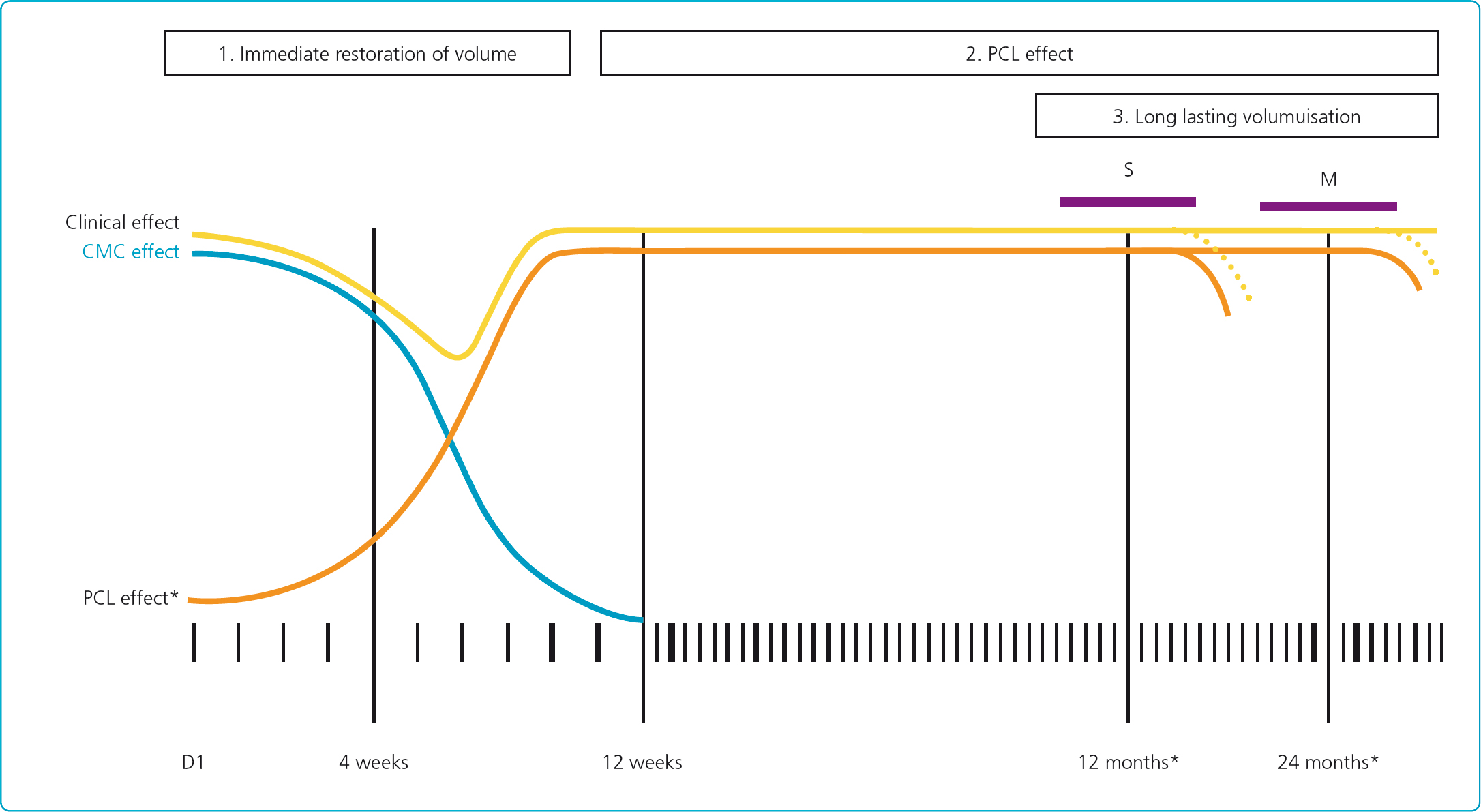

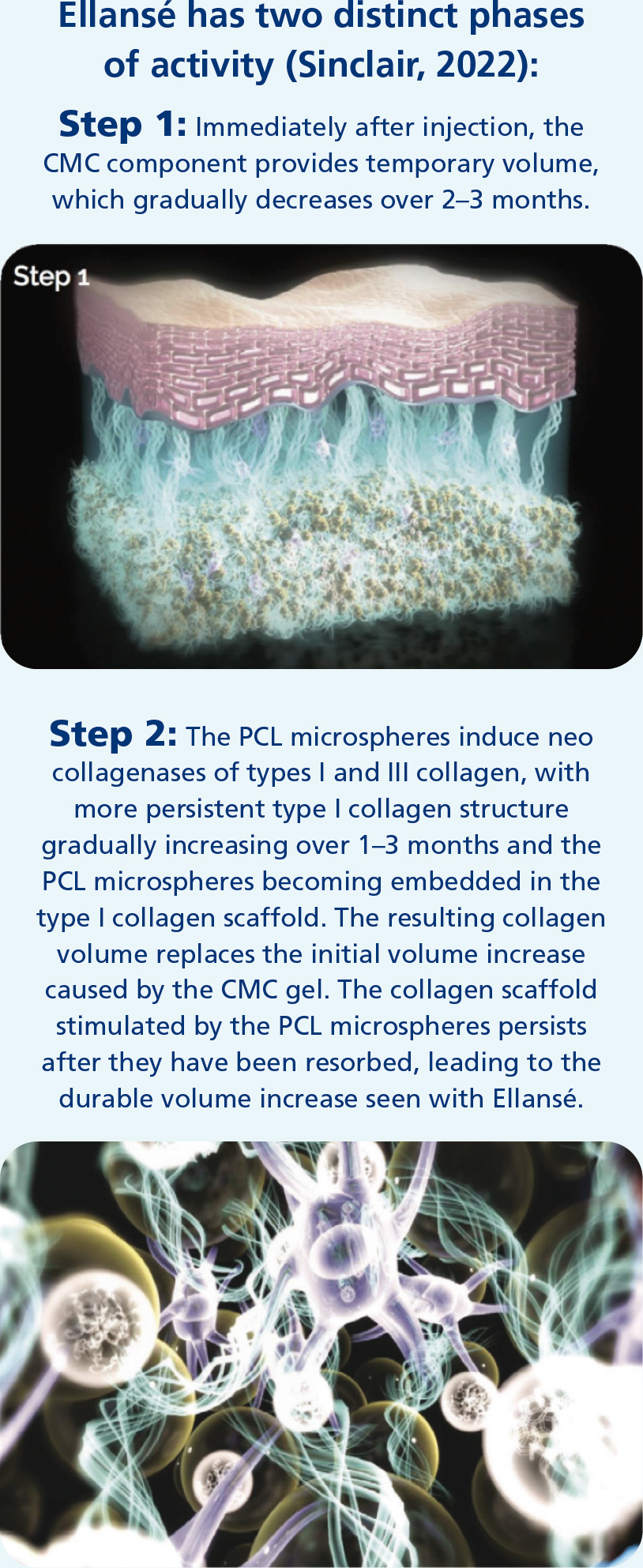
Ellansé gel's elasticity is greater than that of volumising hyaluronic acid (HA), meaning that projection and volumisation of the injected area are instantly visible. Because the collagen-stimulating PCL microspheres are maintained in the injection area, aesthetic improvement is also more long-term than that seen with HAs (Galadari et al, 2015). Ellansé also has excellent rheological properties and combines high elasticity with specifically designed viscosity that is suitable for subdermal injection (Christen and Vercesi, 2020). In a randomised, prospective, blinded, split-face, single-centre study comparing Ellansé with HA in 40 patients, nasolabial folds (NLFs) treated with Ellansé showed statistically significant improvements on the Wrinkle Severity Rating Scale, and greater improvements on the Global Aesthetic Improvement Scale when compared with NLFs treated with an HA based dermal filler (Galadari et al, 2015).
Ellansé also improves skin quality, enhancing density, firmness, tonicity and texture from within. A clinical trial was carried out to assess the effect of Ellansé on skin quality parameters in 24 patients up to 24 months post-treatment. Although Ellansé was injected in the subdermis of the midface, patient echographs clearly showed a substantial increase in tissue density in the dermis following treatment with Ellansé, compared with baseline (Moers-Capri and Sherwood, 2013).
This improvement was statistically significant at all time points during the 24-month study. Skin firmness, tonicity and smoothness were also statistically significantly improved with Ellansé, compared with baseline (Moers-Capri and Sherwood, 2013).
There at two versions of Ellansé with different durations of action. This is achieved by varying the length of the PCL chains, allowing predictable, controlled and adjustable bio resorption (Christen and Vercesi, 2020). Only one treatment is necessary.
MaiLi
MaiLi is a range of HA-based dermal fillers developed in Switzerland. It uses patented technology and processes to deliver a supremely supple spring-like gel with outstanding volume, projection power and longevity that is unmatched by other HA-based dermal fillers on the market (Sinclair, 2021).

MaiLi benefits from the unique, patented, OxiFree™ manufacturing technology that cannot be offered by other brands of HA filler. MaiLi OxiFree™ technology and the OxiFree™ manufacturing process extracts significant amounts of oxygen from the system allowing high-molecular-weight HA chains to form under an inert atmosphere. The properties of suppleness, volume, projection and longevity that are associated with MaiLi are down to the four steps of the unique OxiFree™ manufacturing process (Sinclair, 2021).

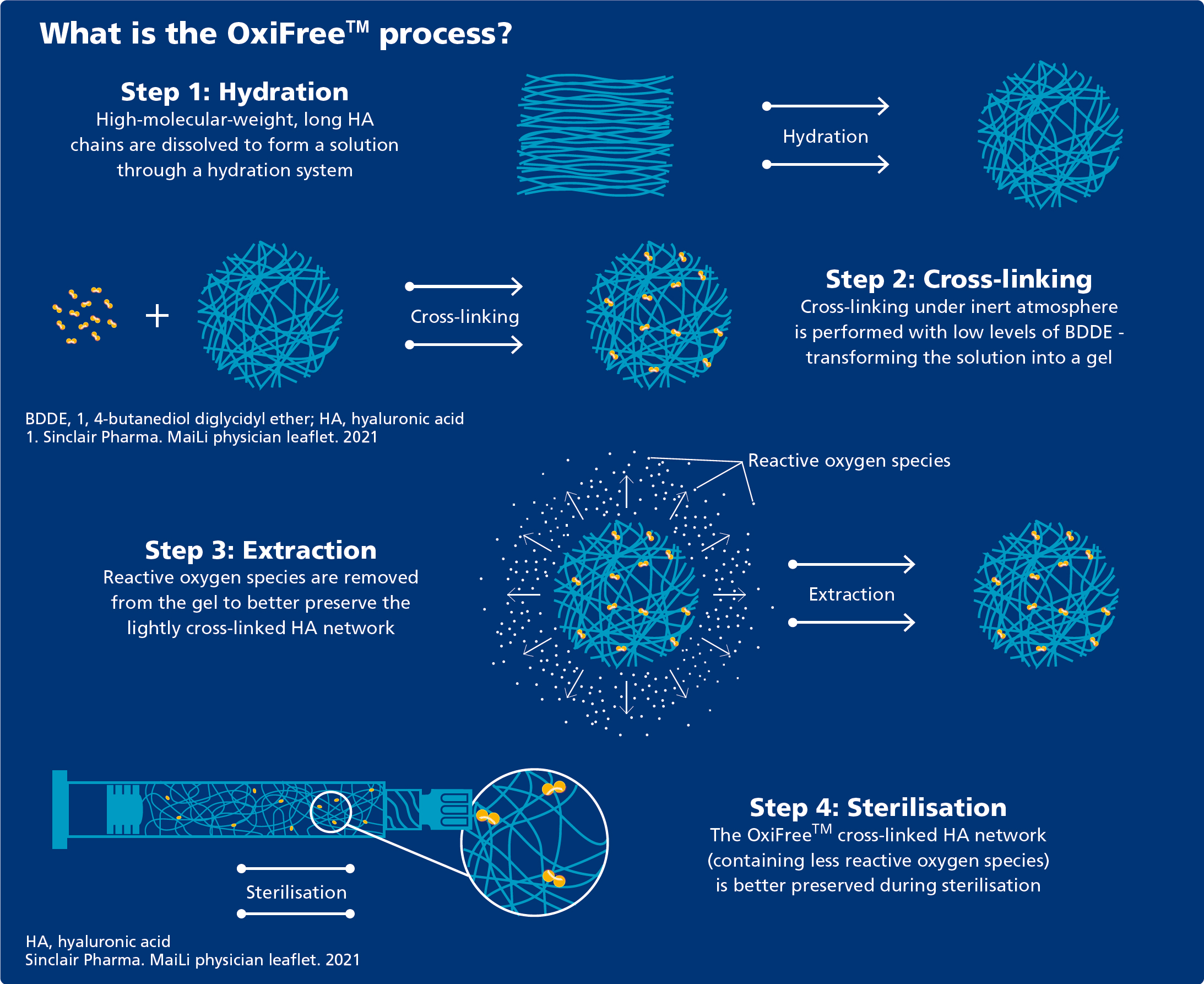
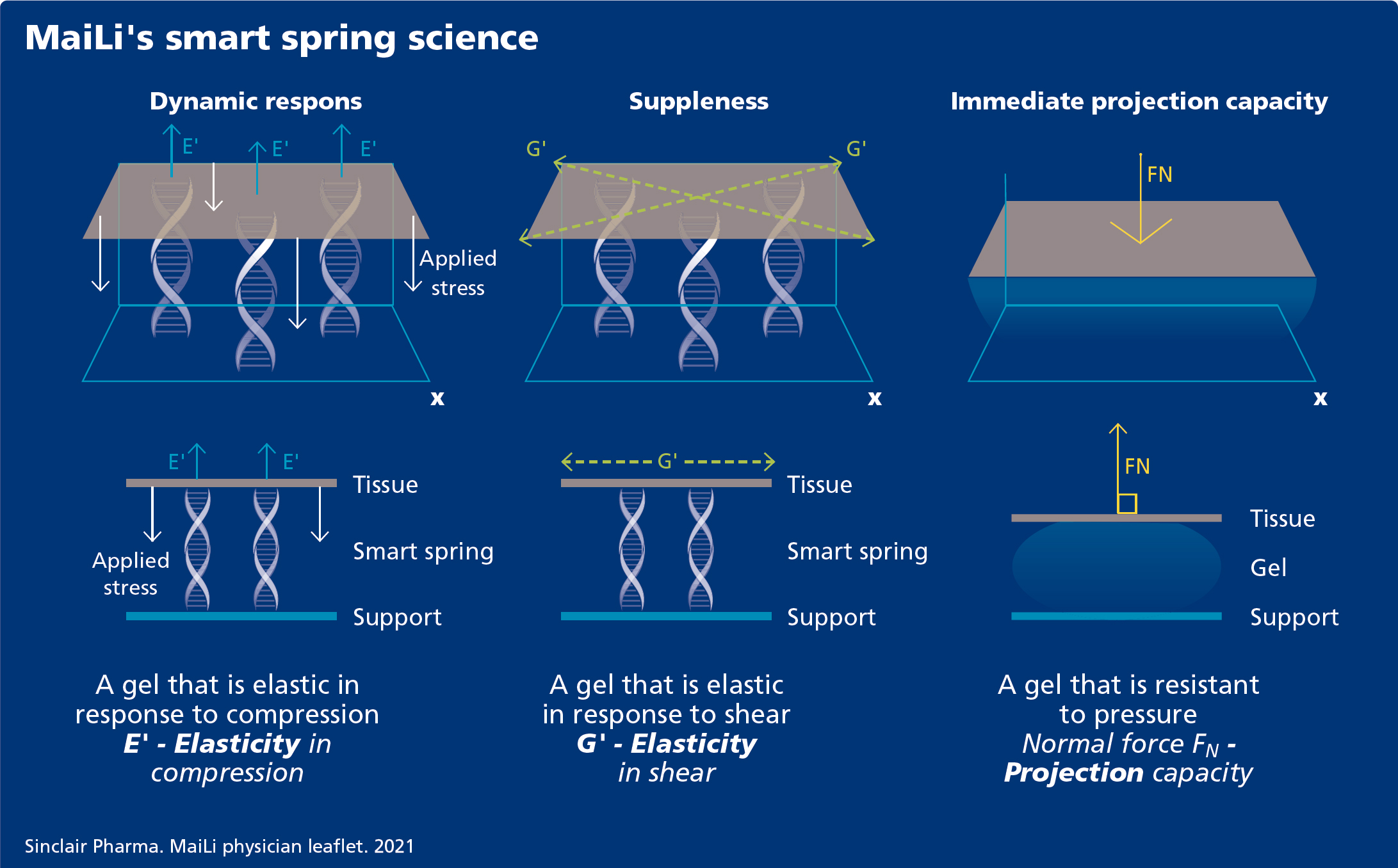
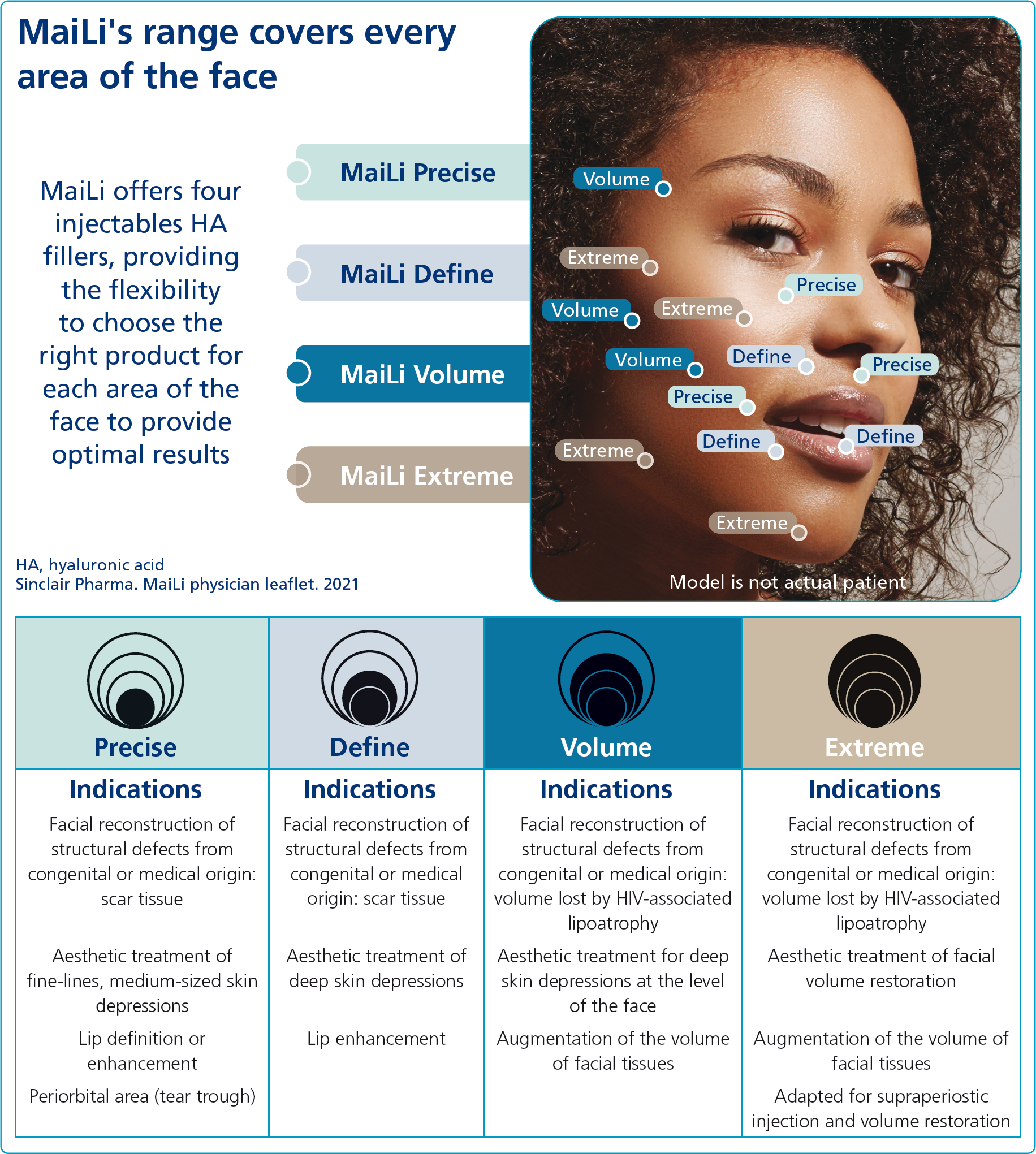
The four steps are:
- Step 1: Hydration. High-molecular-weight, long HA chains are dissolved to form a solution through a hydration system
- Step 2: Crosslinking. Under inert atmosphere is performed with a low level of 1,4-butanediol diglyceryl ether (BDDE) – transforming the solution into a gel
- Step 3: Extraction. Reactive oxygen species are removed from the gel to better preserve the lightly crosslinked HA network
- Step 4: Sterilisation. The OxiFree™ crosslinked HA network (containing less reactive oxygen species) is better preserved during sterilisation. Importantly, the OxiFree™ technology used during the sterilisation process reduces the amount of chemical crosslinking required and protects the HA network from degradation.
Smart Spring Science
Due to the naturally long, high-molecular-weight HA chains, MaiLi's OxiFree™ technology creates a uniquely supple gel that responds exceptionally well to pressure, while remaining flexible, with natural movement and dynamic expression. After the gel is introduced, it is supported by either tissue or bone, depending on the treatment area, represented by the X and Y axis. The Z axis represents the perpendicular direction from the plane of the support (Sinclair, 2021).
The characteristic movement and behaviour of MaiLi's HA network can be imagined as a series of smart springs that follow the natural movements of the face, with supple elasticity. The injected gel is in constant contact with the surrounding tissues. The gel bounces back from pressure and returns to its initial shape. MaiLi is soft and supple and follows the natural movement of the face (Sinclair, 2021).
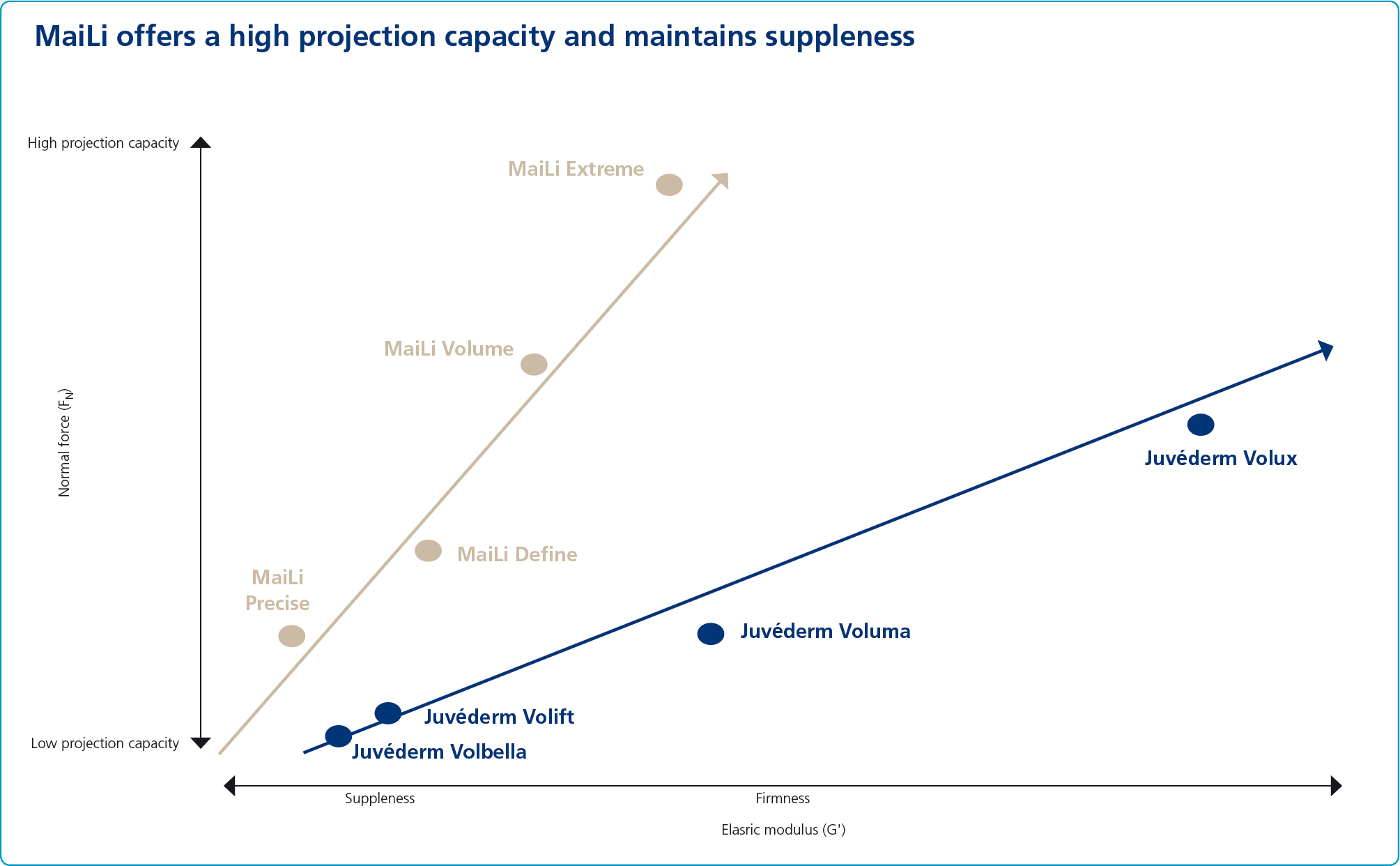
My experience with Ellansé and MaiLi
Patient and product selection is dependent on a full patient skin assessment, medical history and the patient's needs.
Why Ellansé?
- It is the most powerful regenerating collagen stimulator. Aesthetic medicine is now concentrating on regenerative treatments and patients are requesting these treatments
- Ellansé is the product that will give long-lasting and natural results
- Ellansé is licensed to use both periosteal and sub dermal in the face, but not in the lips or tear trough area
- The degradation of Ellansé constituents is completed by hydrolysis, leaving just water and carbon dioxide
- The final volume within the treated area is greater that the volume of Ellansé injected. There is no need to do touch ups. Due to the formation of Collagen type 1, volume is 20¬–30% greater
- I have been injecting with Ellansé for 12 years and I have seen remarkable changes in patients' skin quality, especially for my more mature patients.
Why MaiLi?
As previously discussed, the rheology, patented spring technology and OxiFree make it easy to understand the beautiful, natural treatments that can be achieved with the MaiLi range. The difference from any other HA filler is as follows:
- How cohesive it is in the tissues, allowing the patient to use animated expressions without the filler being obvious in the skin. It moves with the skin and springs back to the original position.
- Less inflammatory reaction and swelling even in the lips, due to the OxiFree technology.
- With MaiLi extreme, I can achieve amazing projection with 24% less product than equivalent products.
- The suppleness and projection capacity of the product allows me to provide a treatment with natural results, longevity and patient satisfaction.
MaiLi has the same indications for all Hyaluronic fillers.
Initially, I always carry out a comprehensive consultation to educate the patient on the products and how they perform in the skin. Depending on the patient's medical history, preference, and my guidance, a filler is selected. In some cases, we may use a combination of both. If I want to improve the skin quality, I mostly use Ellansé, but if I want to treat the tear trough and lips on the same patient, I would use MaiLi in those areas.
Both MaiLi and Ellansé give a very natural and effective result. However, the decision to use either, or both, will depend on the patients' expectations and effect needed.
Why select Ellansé?
- It is suitable for patients looking for long-term results.
- To improve skin quality and collagen stimulation.
- For male patients, Ellansé can achieve a very structured and non-hydrophilic result, which male patients tend to prefer.
Why select MaiLi?
- Patients first time having fillers I recommend Maili
- If patients are having first-time fillers, I recommend MaiLi
- MaiLi Precise is effective for tear trough treatment
- MaiLi Precise is effective for lip treatment of mature patients and MaiLi Define is effective for lip projection
- Perfect for immediate effect and beautiful, natural results.
Case study 1: Ellansé S
Patient
- A 58-year-old woman with deep nasolabial and marionette lines. See Figure 9.
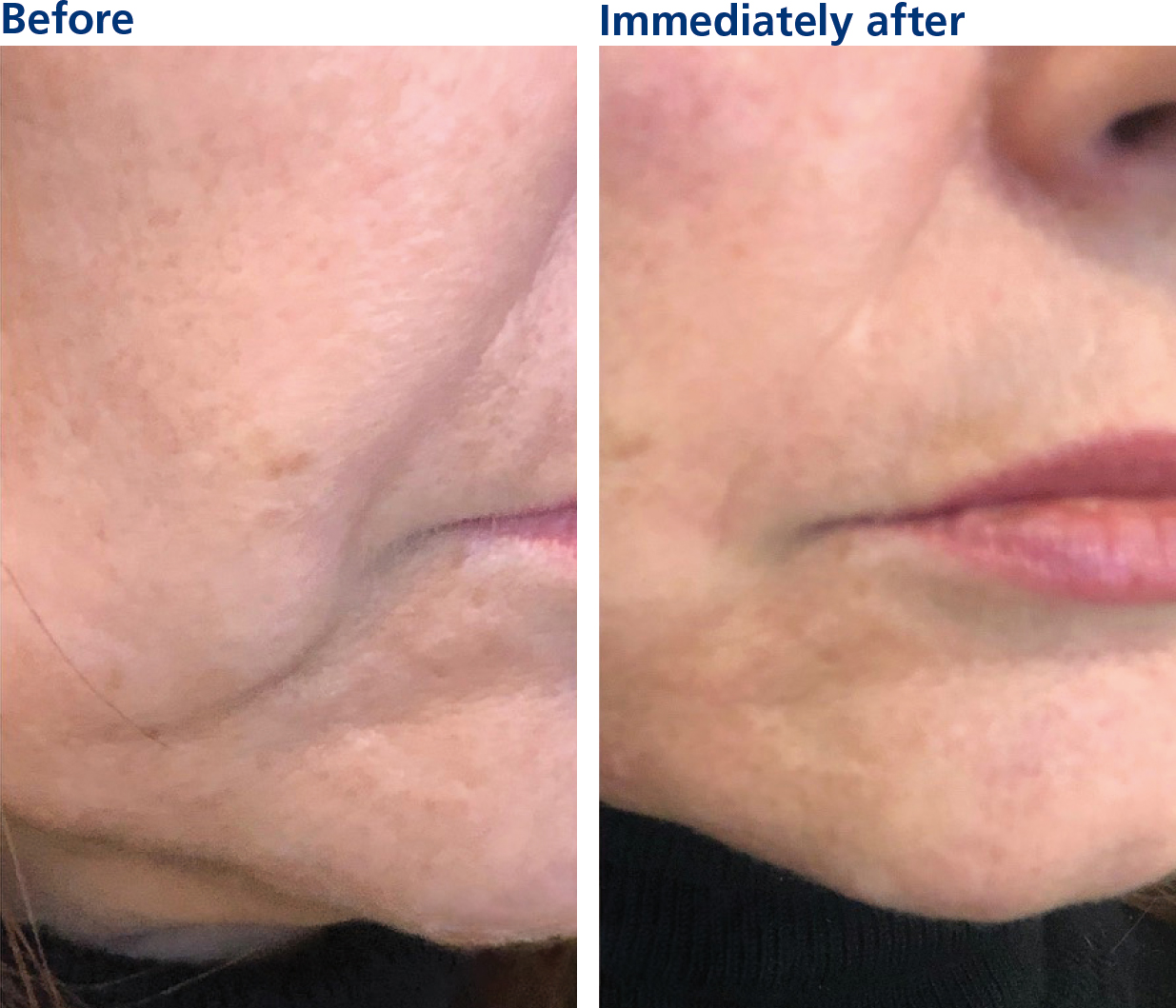
Treatment
- Ellansé S. Nasolabial 0.3 ml subdermal linear threads via 25g canula
- Marionette, and prejowel sulcus 0.7ml subdermal linear threads via 25 g canula.
Result
Immediate support of the tissues and the improvement in the marionette area.
Case study 2: MaiLi Define
Patient
- A 33-year-old woman, medical rhinoplasty anatomy. See Figure 10.
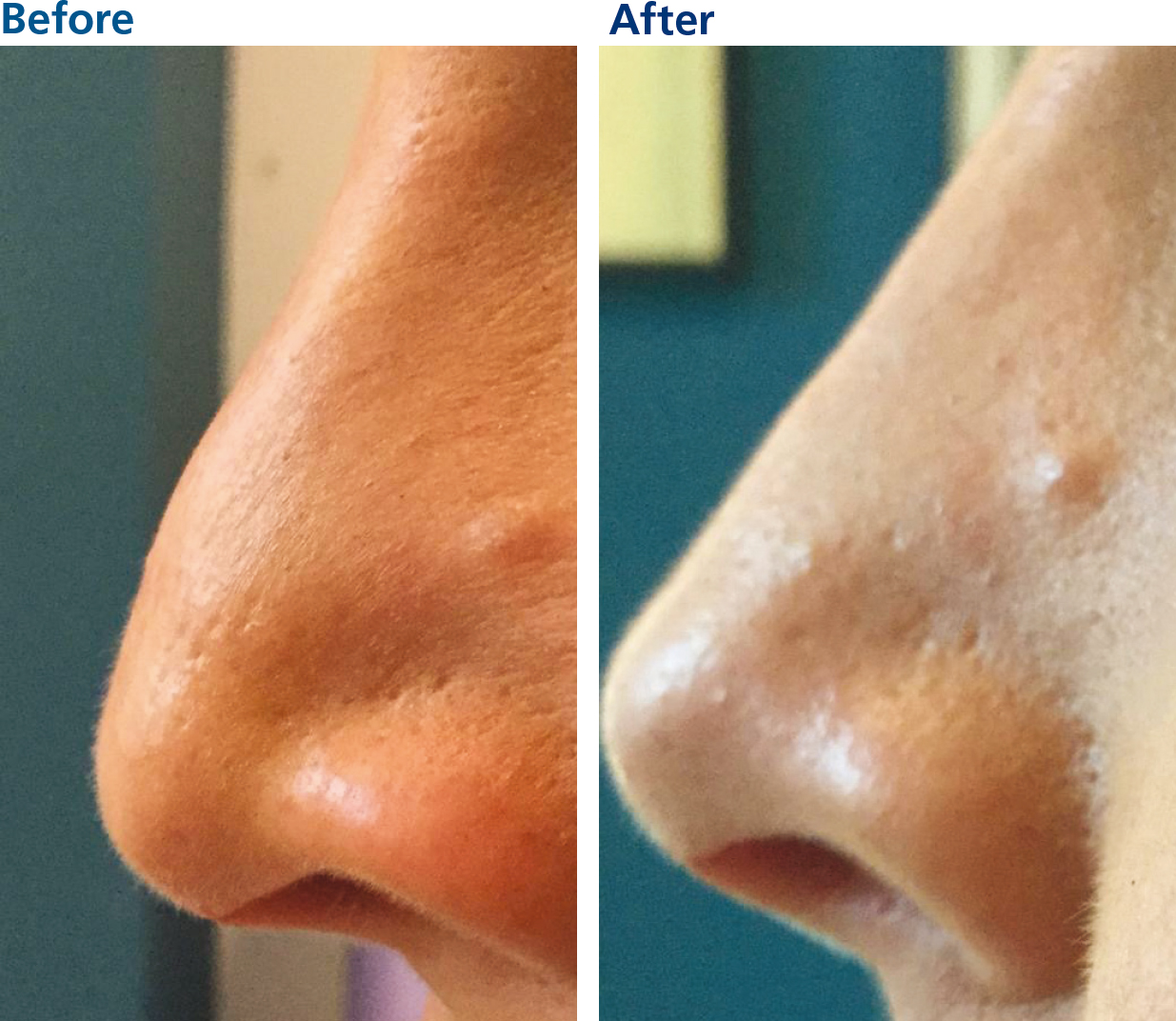
Treatment
- MaiLi Define: two 0.05ml injections midline dorsum periosteal via 30g needle
- MaiLi Define: one 0.1ml injection tip of nose midline via 30g needle.
Result
Patient very happy with improvement.
Case study 3: MaiLi
Patient
- 38-year-old woman seeking natural facial rejuvenation. See Figure 11.
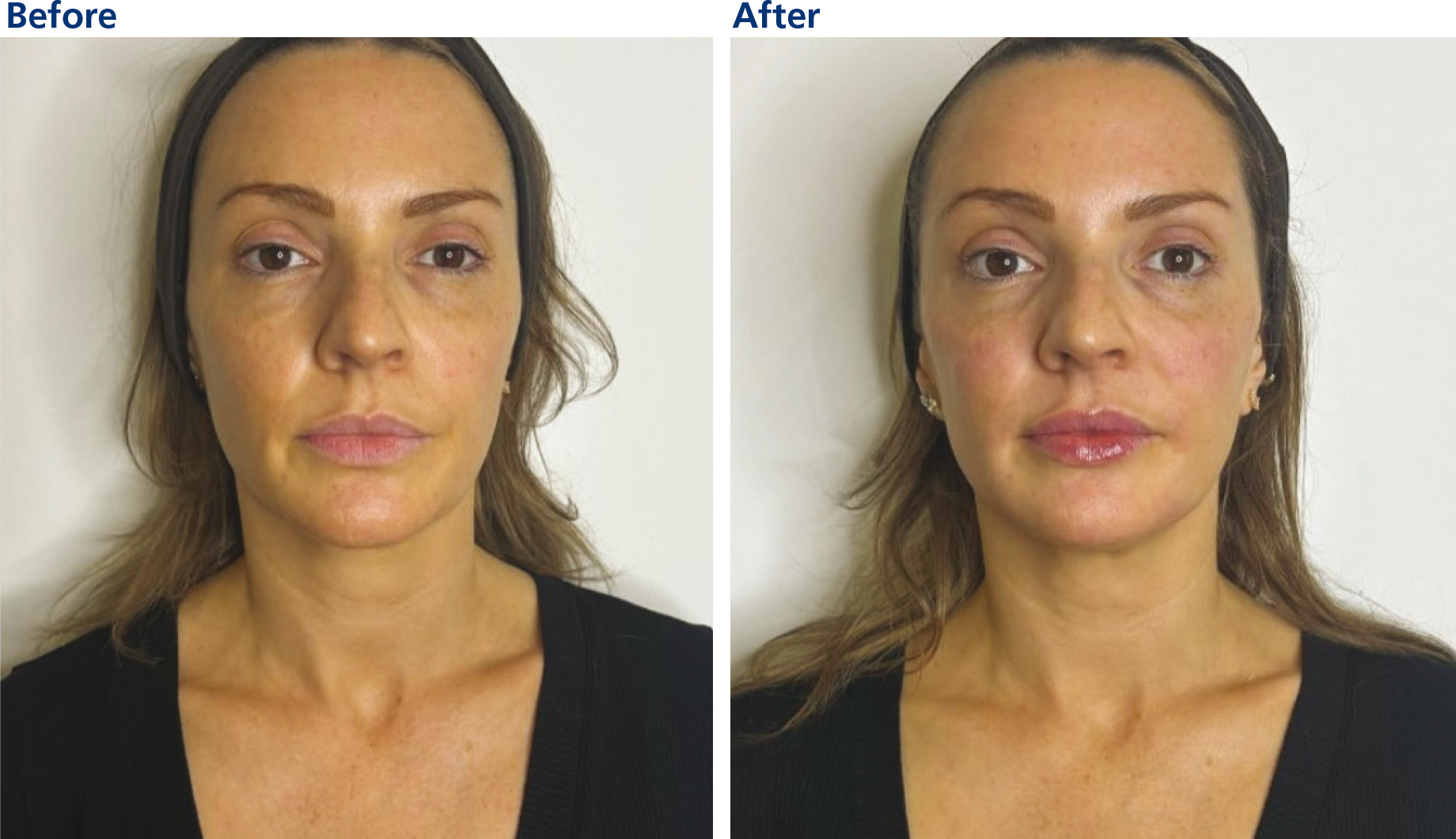
Treatment
- Temples: MaiLi Volume: 0.5ml bolus each side deep to periosteum via 27g needle
- Midface: MaiLi Extreme: two 0.2ml bolus injections periosteum on Zygoma and one 0.3 ml bolus mid face via 27g needle
- Nasolabial – MaiLi Define: right side 0.3ml, left side 0.2ml linear threads via 25g canula
- Marionettes and Prejowel – MaiLi Volume: right side 0.6ml, left side 0.4ml linear threads via 25g canula
- Chin – MaiLi Extreme: 0.3ml periosteal bolus via 27g needle
- Lip – MaiLi Define: 0.8ml in the body liner threads via 30g needle
- Vermillion boarder – MaiLi Precise: 0.5ml via 30g needle.
Unable to treat tear troughs as she had poor lachrymal drainage, which causes fluid retention and therefore contraindicated for treatment.
Conclusion
Both Ellansé and MaiLi are unique, safe and effective dermal fillers. The decision of which to use should be determined by the patients' skin condition, age, areas to be treated and patient's expectations.
The MaiLi range will provide your patient with immediate results, whereas Ellansé S or M will provide a long-term, regenerative collagen stimulating treatment. These two products give the ability to achieve measurable results and increase patient satisfaction.
CPD reflective questions
- What are the key mechanisms of action for collagen stimulators and hyaluronic acid (HA) fillers, and how do they differ in terms of tissue integration and longevity?
- Compare the clinical effects of collagen stimulators and HA fillers on skin quality improvement, including factors such as density, firmness, and texture. How do these effects influence treatment selection for various patient demographics?
- Review the available clinical evidence supporting the efficacy and safety of collagen stimulators and HA fillers in aesthetic treatments. Discuss any notable findings from comparative studies between these two types of fillers.



